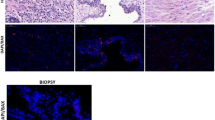Summary
To investigate the relationship of bcl-2, p53, proliferating cell nuclear antigen (PCNA) to cell proliferation, apoptosis and pathological parameters, the patterns of cell growth and turnover in renal cell carcinoma (RCC), formalin-fixed and paraffin-embedded tissue blocks from 34 patients with RCC were examined. Cell proliferation activity was detected by PCNA immunostaining and the proliferation index (PI) was expressed as a percentage of the PCNA-positive cells in the tumor cells. Apoptosis was detected by terminal deoxy-nucleotidyl transferase-mediated dUTP-biotin nick end labeling (TUNEL), and the apoptotic index (AI) was expressed as a percentage of the TUNEL-positive cells in the tumor cells. Expressions of bcl-2 and p53 were assessed immunohistochemically. Our results showed that the PI ranged from 6.0% to 24.0% (median 12. 3%) and the AI from 2.0% to 8.0% (median 5.4%) in RCC. The expression of the bcl-2 protein was demonstrated in 15 cases (44.1%); the expression of the p53 protein, however, was seen in only 3 case. bcl-2 positivity was not associated with PI or AI or any pathological parameters. There were close associations between PI and tumor grade and stage, and a significant relationship between AI and the tumor grade of RCC. Our study suggests that bcl-2 positivity was not associated with PI or AI or any pathological parameters. There are close associations between PI and AI and tumor grade and stage of RCC. Active cell proliferation may be accompanied by frequent apoptosis in RCC.
Similar content being viewed by others

References
Onda H, Yasuda M, Serizawa Aet al. Clinical outcome in localized renal cell carcinomas related to immunoexpression of proliferating cell nuclear antigen, Ki-67 antigen, and tumor size. Oncol Rep, 1999, 6: 1039
Levine A J, Momad J, Finlay C Aet al. The p53 tumor supressor gene. Nature, 1991, 351: 453
Hofmockel G, Wittmann A, Dammrich Jet al. Expression of p53, bcl-2 in primary locally confined prognostic renal cell carcinoma: no evidence for prognostic significance. Anticancae Res, 1996, 16: 3807
Sejima T, Miyagama I. Expression of bcl-2, p53 oncoprotein and proliferating cell nuclear antigen in renal cell carcinoma. Eur Urol, 1999, 35: 242
Uchida T, Wada C, Schitara Tet al. Infrequent involvement of p53 mutation and loss of heterozygosity of 17p in the tumorigenesis of renal cell carcinoma. J Urol, 1993, 150: 1298
Vasavada S P, Novick A C, Willians B R. p53, bcl-2 and Bax expression in renal cell carcinomas. Urology, 1998, 51: 1057
Huang A, Fone P D, Gandour-Edwards Ret al. Immunohistochemical analysis of bcl-2 protein expression in renal cell carcinomas. J Urol, 1999, 162: 610
Zhang X H, Takenaka I. Cell proliferation and apoptosis with bcl-2 expression in renal cell carcinoma. Urology, 2000, 56: 510
Author information
Authors and Affiliations
Additional information
ZHU Zhaohui, male, born in 1968, Associate Professor
Rights and permissions
About this article
Cite this article
Zhaohui, Z., Shian, X., Ping, C. et al. The relationship of expression of bcl-2, p53, and proliferating cell nuclear antigen (PCNA) to cell proliferation and apoptosis in renal cell carcinoma. Current Medical Science 24, 354–357 (2004). https://doi.org/10.1007/BF02861866
Received:
Published:
Issue Date:
DOI: https://doi.org/10.1007/BF02861866



